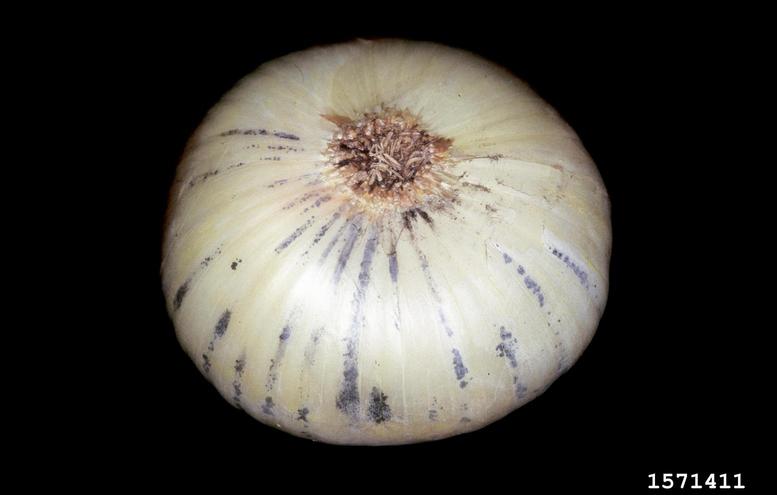
Creative Commons License licensed under a Creative Commons Attribution-Noncommercial 3.0 License.
https://www.invasive.org/browse/detail.cfm?imgnum=1571411
Quick Facts About Black Mold in Onions
There have been some questions about Black Mold in onions the last couple of weeks. I wanted to share with you what we know about the disease, and some possible considerations on management.
For many of you, this may be old news, but I wanted to share some basic facts about the disease as a refresher for myself and those who aren’t familiar with it.
Background/History: Black mold of onions is a fungal disease. The scientific name of this pathogen is Aspergillus niger. It is found around the world, and it can affect many other crops. The spores that cause the disease are everywhere, in the soil and in the air. It usually only poses an issue with onions when conditions are right for it to develop (hot and humid).
Symptoms: The fungus is first detected as an area covered with a black sooty mass (made up of microscopic spores) on the neck or outer scales, where injury, disease, or toppling of the foliage has caused an opening in the skin. Fungal spores may develop between dry, dead outer scales and the first inner fleshy scales of the bulb.
Disease cycle: The Black Mold fungus grows on dead plant and animal tissues and spores are very common in the air and soil everywhere. Infection of onion bulbs can occur in the field or in the packing shed. Infection frequently occurs through injured tissue, such as from cuts, bruises, or damage from other onion diseases. Temperature and humidity play a crucial role in the development of the disease:
- The minimum temperature for growth of Black Mold is 590F.
- The optimum temperature for growth of Black Mold is 820 – 930F.
- Black Mold will not grow in temperatures greater than 1160F
- Fungal growth is significantly slowed when the relative humidity is below 76%
- When the relative humidity is above 81%, growth can occur rapidly (3-6 hours).
- Free moisture must be present on onions for 6 – 12 hours for infection to occur. This can easily happen in the field, and also in the packing shed when onions “sweat” from cooling or temperature changes.
Past Research and Findings from UGA:
- Three on-farm trials were conducted in Toombs and Tattnall 2013 and 2014 to see if fungicides could be used in the field to reduce black mold, and to look at how on farm drying of onions affects the disease. None of the products used significantly reduced the disease. Drying onions also increased the severity and incidence of Black Mold. Read the full report here: https://secure.caes.uga.edu/extension/publications/files/pdf/AP%20114_1.PDF
- In 2012, UGA conducted a trial looking at post-harvest fungicides to control black mold in Vidalia Onions. These products helped control the disease, but logistics/feasibility/cost could prohibit this practice. See the full report here: https://secure.caes.uga.edu/extension/publications/files/pdf/AP%20109_1.PDF
- There have also been some questions about different storage types (CA, refrigeration, ozone) and if one is better than the other for black mold. Some evidence would suggest that ozone may help, but I have not been able to find any UGA research to support this. If you know of any research from somewhere else that has been done with storage facilities and black mold, please let me know. This may be something we need to look at in the future.
Management:
- In the field, manage your onions for other diseases. These can weaken the plant and create an entry point on onions for Black Mold.
- Timeliness! Prompt harvest and post-harvest management of onions is critical, especially as temperatures rise later in the season.
- Minimize bruising or injury of tissue. This includes during harvesting, transport, pre-grading, grading, and packing. Bruises or injury that are not obvious to the naked eye create entry points for the disease.
- Minimize “sweating” of onions during cooling/drying process. This creates moisture needed for Black Mold to develop.
- Temperature and Humidity control are critical: Below 600F and under 76% relative humidity is best.
- Heated drying of Vidalia Onions is necessary in most situations. Keep in mind, however, that this process often makes Black Mold worse (because we dry at temperatures optimal for development of the disease), especially if the onions already have an established infection.
Sources for this info:
Schwartz, Howard F., Mohan, S. Krishna, et al. “Compendium of Onion and Garlic Diseases.” APS Press, 1995.
Sanders, F.H. Jr, Langston, D.B., Foster, M. “Black Mold Post Harvest Fungicide Trial, 2012.” Georgia Onion Research-Extension Report. https://secure.caes.uga.edu/extension/publications/files/pdf/AP%20109_1.PDF
Sanders, F.H. Jr, Riner, C.M., Edenfield, J., Tyson, C.T., and Foster, M. “Effect of Pre-harvest Fungicide Sprays and Commercial Drying on Black Mold of Onion.” https://secure.caes.uga.edu/extension/publications/files/pdf/AP%20114_1.PDF
UC IPM Pest Management Guidelines: Onion and Garlic, UC ANR Publication 3453. https://www2.ipm.ucanr.edu/agriculture/onion-and-garlic/black-mold/